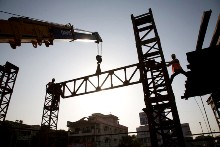
Typical street scene in Santa Ana, El Salvador. (Photo: iStock)
IMF Survey : Drop in Investment Slows Indian Growth
February 6, 2013
- Growth expected to decline to 5.4 percent this year
- Facilitate investment by addressing supply bottlenecks, say IMF economists
- Comprehensive overhaul of fuel subsidies is key to bringing down budget deficit
Since recovering rapidly from the global financial crisis, India’s economy has slowed substantially, and its growth rate is expected to decline further in the coming year for a range of domestic reasons, say IMF economists in their annual health check of India’s economy.

India’s Quadrilateral Highway which will connect four major Indian cities. Reforms are needed to facilitate infrastructure investment, says the IMF (photo: Ed Kashi/Corbis)
ECONOMIC HEALTH CHECK
In 2011/12, India’s growth rate was 6.5 percent. That figure is expected to drop to 5.4 percent in 2012/13. Despite the poor outlook for the global economy, this is a far larger drop than might be expected.
Growth outpaces investment
Between 2004–11—a period that includes the global financial crisis—India’s growth averaged 8.3 percent a year. High growth and higher incomes added to demand, especially for food, electricity, and transportation.
This growth outpaced new investment in power plants, roads, and coal production. As concern about corruption scandals slowed approvals for new projects, supply bottlenecks became evident, culminating in the July 2012 blackout across much of India, when a tenth of the world’s population lost power for up to two days.
India’s recently published 12th Plan calls for major investments in infrastructure, health, and education, as well as for continued poverty reduction, but in their report, IMF economists say reforms to facilitate investment—especially in infrastructure—together with lower costs to do business, are key to restoring high growth.
The government has already taken significant steps to restore growth, for example by laying out a plan to cut the losses of local power companies, creating the Cabinet Committee on Investment, and relaxing some restrictions on foreign direct investment.
But more needs to be done. Addressing India’s long-term energy needs, for example, will require solving complicated problems related to coal (which powers most of India’s electricity plants), while easing traffic jams will require facilitating the acquisition of land to widen roads or build new ones.
Addressing budget deficits and inflation
A common response to slow growth is the use of countercyclical fiscal or monetary policy, but this is inappropriate for India. High inflation means there is little room to cut interest rates, while the country’s fiscal deficit (forecast to be 8.7 percent this year—the highest among major emerging markets) means that controlling, rather than raising, spending is a priority.
The government has already moved to lower fuel subsidies, which disproportionately benefit richer people. It will need to do more to free sufficient resources for 12th Plan priorities, including a comprehensive reform of fuel subsidies.
Financial sector threats
In their report, the IMF economists warn about threats posed by the financial sector. The number of nonperforming loans has risen recently, and the current slowdown raises the prospect that this trend will continue for some time.
In the long run, ensuring India’s financial system is able to underwrite strong growth will require pushing forward with financial reforms, such as developing the corporate bond market and gradually lowering government-mandated purchases by banks of government debt.


